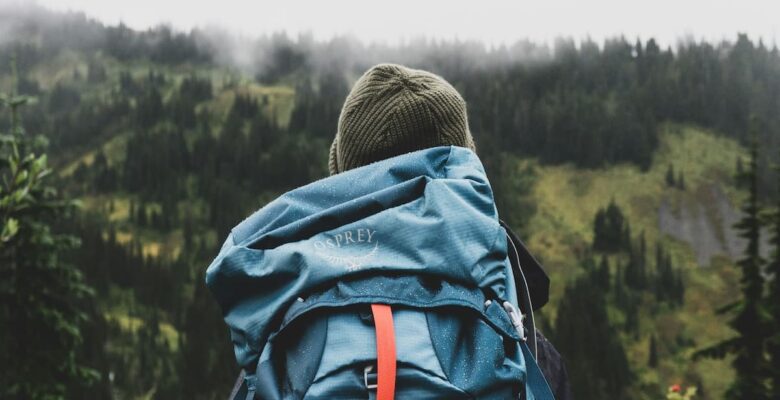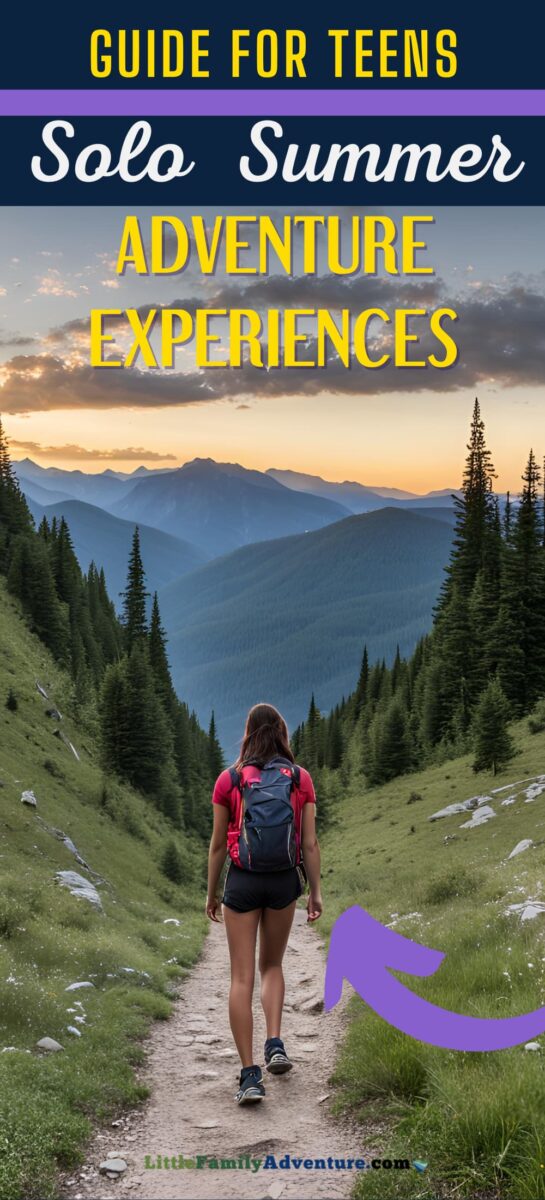The summer following your high school graduation is supposed to be unforgettable. You’re finally free from the burden of school and can spend the season before college or work begins on a solo adventure doing whatever you like.
Rather than spending this precious liminal period sleeping in or staying up late playing video games, consider tapping into your adventurous side and planning a solo adventure this summer. An extended backpacking excursion, sightseeing tour, or road trip is the perfect way to announce your independence to the world while creating unforgettable memories.
This article contains affiliate links. We earn from qualifying purchases.
However, you’ll still need to take some precautions if you want to stay safe while on your first adventure as an adult. Even simple preventative measures, like downloading a few hiking apps to track your trails, can help you stay safe and have fun while you transform from a teenager into a young adult.

Planning an Adventure
Before you pack up your car and hit the road, you need to do some serious planning. You can’t expect to rock up at a campsite and find a vacant lot and should put some time into considering what you’ll eat when you’re on the road. Not only will this keep you safe, it will greatly improve the experience you have on your post-grad adventure. Start planning your adventure by answering some simple questions:
- What sights do you want to see? Do you want to visit hot springs in the mountains, or surf on the coastline?
- How much time do you want to spend in towns and cities?
- What prior experience do you have with camping and road-tripping?
- How much time do you want to spend away from home?
Once you answer these big-picture questions, you can start to plan the finer details. For example, if you’re planning to hike as many trailheads in the backcountry as possible, you should make a shortlist of nearby shelters and hospitals lest you twist an ankle when you’re on your own. Answering the big-picture questions will help you plan and pack properly, too, as you may need bear spray when hiking in National Parks or a surf helmet if you plan on catching waves near coral reefs.

Research Your Route
Once you have an idea of your destination, you’ll need to plan your route. As well as being a lot of fun, route planning helps you get a better understanding of where you’ll be going and what to expect when you get there. When researching your route, take note of factors like:
- Road features (are you driving on highways or unpaved mountain roads?);
- Rest stops and scenic viewing sights;
- Nearest towns or cities in case you need to resupply;
- Alternative routes in case of road closures or traffic jams;
- Trailhead length and difficulty ranks.
You can use your phone to plan your route and make adjustments as you go. If you’re hiking when you arrive, consider using hiking apps that include interactive trailhead features to tell you more about the route you’re going to take. These apps will also give you a way to log your progress and share updates with your family and friends.
AllTrails is a free mobile app and website with detailed, hand-curated trail maps, along with crowd-sourced reviews and photos. With 300,000+ trails, users can filter to find the route that’s right for them.
Upgrade to the PRO version for offline maps and more.
Know Your Limits
There’s nothing wrong with safely testing your boundaries and getting outside of your comfort zone when you’re in your late teens. Doing so will give you the confidence you need to enter the adult world and is a great way to ensure that fear doesn’t keep you from forming powerful, positive memories.
However, if you do want to push yourself, it’s still prudent to know your limits. This is key if you’re planning a camping or backpacking trip, but have little experience in the great outdoors. Rather than jumping in at the deep end, start with smaller excursions at pre-established campsites closer to home. This will help you understand some of the challenges you’ll face while on a solo adventure and will give you some much-needed experience.

Before partaking in an extended solo adventure in the wilderness, consider gaining experience with local outdoor groups first. This will teach you foundational outdoor skills that will keep you safe when you’re on your own in the backcountry. Experienced backpackers will give you crucial tips, like how and where to store your food when in bear country, and will ensure that you’re fully prepared to look after yourself when away from home.
If you start to get the sense that you’re in over your head, trust your gut and remove yourself from the situation. Research shows that your intuition is a biological fail-safe that was evolutionary designed to help you protect yourself. It acts faster than cognitive reasoning, too, meaning that your gut may be telling you something that your mind is missing. This approach can help you see the benefits of fear, rather than being ruled by it. This is key when far from home, as you’ll need to make rational decisions to stay safe while on your solo adventure.

Best Packing Practices
When the time finally comes to pack up and head out, you’ll need to make the most of the space in your car. After all, an extended solo adventure probably means that you’re packing at least a week’s worth of food, as well as your sleeping bag, tent, clothes, and cooking utensils.
Rather than jamming all this in the trunk and driving away, pack with care and consideration. This will help you get to any emergency items, like first-aid kits, quickly and will ensure that you know where everything is when you park up at your first location.

If you are packing food in a cooler, you’ll need to make the most of the cold storage. You can pack a cooler properly by:
- Adding ice to the bottom of the cooler first;
- Layering ice between food items;
- Freezing any meat before putting it in your cold box;
- Keeping it in the shade and do not open it unless necessary.
Following these steps will reduce the risk of food spoiling and will keep you well-fed for the foreseeable future. Just be sure to top up your ice when possible and don’t risk eating food that might be unsafe or questionable. This approach to food storage will keep you safe and ensure that you can cook up some great meals while enjoying the great outdoors.
Experiences to Consider
The idea of a solo adventure is always alluring. However, if you’re used to spending your free time gaming or hanging out with friends, you may not have a clear idea of what a solo adventure should look like. This is entirely normal, and you shouldn’t feel embarrassed by your lack of experience. If it’s your first time going on an adventure of your own, consider some activities and experiences like:
- Backpack a portion of a trail like the Pacific Crest Trail or the Appalachian Trail.
- Spend a few weeks at an iconic beach like Daytona, Carlsbad, or Santa Monica.
- Road trip across iconic highways like Route 66 or Blue Ridge Parkway.
- Explore trailheads and campgrounds in national parks like Arches, Grand Teton, or Acadia.
These types of trips will result in great memories and give you plenty of options to consider when planning your trip. They’re a little more on the tourist-friendly side, too, meaning you can connect with support services should something go awry. This makes a break in Arches or at Daytona Beach the perfect way to assert your summer independence without getting into a dangerous situation.

Finding Funding
Getting away on a solo adventure is a great way to start life after school. However, if you aren’t in the fortunate position to afford a break for yourself, you may be able to find funding through local groups and outdoor initiatives. You may need to compromise on some of your expectations, but you can still have a great trip that will help you have an unforgettable summer.
Get the ball rolling by reaching out to local outdoor programs in your area. If you’re unsure of how to find outdoor programs, consider reaching out to your high school’s outdoor program before you graduate. If your school isn’t in a position to support you, consider getting in touch with groups like:
- Outward Bound USA;
- REI Outdoor Classes;
- National Center for Outdoor Experiences.
Some of these programs will require a fee but can minimize your overall costs. Programs like the National Recreation Foundation may help put you in touch with relevant sponsorships and grants to help fund your interests. Just be aware that many of these programs will require you to partake in group activities. While this may not be the solo adventure you’d planned for, it will give you a chance to meet new people and build a social network of similarly-minded outdoors people.
Conclusion
The summer following your graduation is the perfect time to embark on a solo adventure. You have few responsibilities and can spend the long days making memories that will last forever. But before you go, be sure to plan ahead and share your itinerary with your family or friends. This will keep you safe when you’re on the road and improve the quality of the experience you’ll have when on your adventure.




This article is spot-on! Planning a solo adventure post-grad is super exciting. I once planned a road trip without much prep and had some hiccups. Now I’d start by answering those questions. How about you? Any dream destinations for your solo adventure?